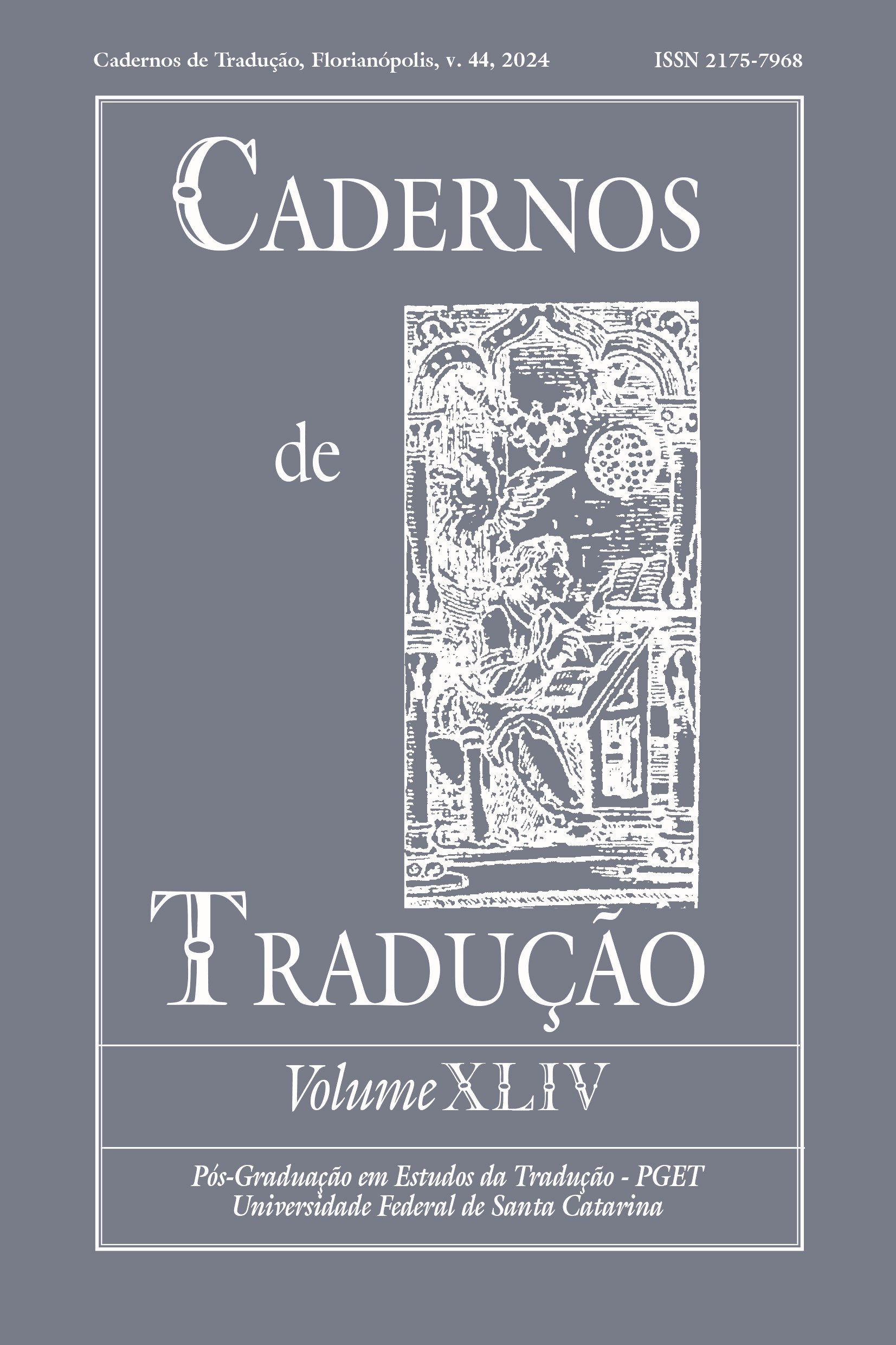Esforço temporal em processos de escrita e de pós-edição acadêmicas na área de educação
DOI:
https://doi.org/10.5007/2175-7968.2024.e96629Palavras-chave:
escrita acadêmica, tradução automática, pós-edição, esforço temporalResumo
A tradução automática tornou-se mais popular nos últimos anos, sendo largamente utilizada por diversos usuários, sejam eles leigos, tradutores profissionais ou aqueles que precisam produzir textos acadêmicos em uma língua que não dominam (Bowker & Buitrago Ciro, 2019). Mesmo com os recentes avanços tecnológicos, ainda é necessária a correção, ou pós-edição, dos textos traduzidos automaticamente, o que não deveria demandar mais esforço que a produção de textos diretamente na língua-alvo. Nessa perspectiva, este estudo visou analisar o esforço temporal despendido para realizar três tarefas distintas envolvendo o português brasileiro (L1) e o inglês (L2): escrita na primeira língua (EL1), escrita na língua adicional (EL2) e pós-edição na língua adicional (PEL2). Foram analisados os processos dessas produções textuais realizadas por três participantes (P01, P02 e P03), doutorandos da área de Educação, que executaram essas tarefas em ordens diferentes. Para a coleta, utilizaram-se um questionário prospectivo, o programa Translog©-II, o Tobii Studio Eye Tracking Software©, o OBS Studio, um relógio de pulso do tipo smartwatch, e protocolos retrospectivos guiados. Os resultados apontaram que a EL2 demandou mais tempo dos participantes, possivelmente devido à média proficiência linguística na L2. Contudo, o tempo despendido nessa tarefa foi inversamente proporcional à sua posição na ordem das tarefas. Observou-se, também, que a tradução automática tem efeito facilitador sobre a PEL2, demandando menos tempo que a EL2. Finalmente, constatou-se que o esforço temporal combinado entre EL1 e PEL2 foi menor que o da EL2. Apesar de a pós-edição não ser realizada com muita frequência no meio acadêmico e demandar mais esforço para textos mais complexos, os resultados sugerem que esta pode ser uma forma mais eficiente de produção textual na L2, quando a escrita na L1 e a pós-edição em L2 demandarem menos tempo do que a escrita em L2.
Referências
Bowker, L., & Buitrago Ciro, J. (2019). Machine Translation and Global Research: Towards Improved Machine Translation Literacy in the Scholarly Community. Emerald Publishing Limited.
Casula, M., Rangarajan, N., & Shields, P. (2021). The potential of working hypotheses for deductive exploratory research. Quality & Quantity, 55, 1703–1725. https://doi.org/10.1007/s11135-020-01072-9
Ferreira, A. A. (2010). Direcionalidade em tradução: uma investigação do processamento cognitivo de tradutores profissionais em tradução direta e inversa no par linguístico inglês-português. [Dissertação de mestrado]. Universidade Federal de Minas Gerais. https://repositorio.ufmg.br/handle/1843/LETR-8SVNBP
Ferreira, A. A. (2013). Direcionalidade em tradução: o papel da subcompetência bilíngue em tarefas de tradução L1 e L2. [Tese de doutorado]. Universidade Federal de Minas Gerais. https://repositorio.ufmg.br/handle/1843/MGSS-9BLN48
Fischer, A. (2008). Letramento acadêmico: uma perspectiva portuguesa. Acta Scientiarum. Language and Culture. 30(2), 177–187. https://doi.org/10.4025/actascilangcult.v30i2.2334
Fonseca, N. B. L. (2016). Pós-edição monolíngue: uma análise de indicadores de dispêndio de esforço temporal, técnico e cognitivo. [Tese de doutorado]. Universidade Federal de Minas Gerais. https://repositorio.ufmg.br/bitstream/1843/LETR-AZQMPW/1/1499d
Gonçalves, J. L. V. R. (2020). Em busca de relevância no olhar: à procura de semelhança interpretativa através de dados de rastreamento ocular. Cadernos de Tradução, 40(esp. 2), 17–44. https://doi.org/10.5007/2175-7968.2020v40nesp2p17
Hurtado Albir, A., & Alves, F. (2009). Translation as a cognitive activity. In J. Munday (Ed.), The Routledge Companion to Translation Studies (pp. 54–73). Routledge.
Kasperavičienė, R., Motiejūnienė, J., & Patašienė, I. (2020). Quality assessment of machine translation output: Cognitive evaluation approach in an eye tracking experiment. Texto Livre, 13(2), 271–285. https://doi.org/10.35699/1983-3652.2020.24399
Koehn, P. (2010). Enabling Monolingual Translators: Post-Editing vs. Options. In R. Kaplan et al. (Eds.), Proceedings of the human language technologies: The 2010 annual conference of the North American chapter of the ACL. (pp. 537–545). Association for Computational Linguistics.
Koponen, M. (2016). Is machine translation post-editing worth the effort? A survey of research into post-editing and effort. The Journal of Specialised Translation, 25, 131–148.
Krings, H. (1986). Translation problems and translation strategies of advanced German learners of French (L2). In J. House & S. Blum-Kulka (Eds.), Interlingual and Intercultural Communication (pp. 263–275). Gunter Narr.
Krings, H. (2001). Repairing texts: empirical investigations of machine translation post-editing processes. (G. S. Koby et al., Trad.). The Kent State Univ. Press.
Lea, M. R., & Street, B. V. (1998). Student writing in higher education: An academic literacies approach. Studies in Higher Education, 23(2), 157–172.
Neunzig, W. (2011). Empirical Studies in Translation: Methodological and Epistemological Questions. Traduction, Terminologie, Rédaction, 24(2), 15–39. https://doi.org/10.7202/1013393ar
Santos, Z. B., & Cristofoleti, R. C. (2020). A escrita no contexto universitário: perspectivas para o letramento acadêmico. Revista Gatilho, 19(2), 94–113. https://doi.org/10.34019/1808-9461.2020.v19.27508
Sousa, M. S. C., & Fuza, A. F. (2021). Os discursos acadêmico-científicos voltados à internacionalização dos programas de pós-graduação. Revista Brasileira de Educação, 26, 1–25. https://doi.org/10.1590/s1413-24782021260019
Street, B. V. (1995). Social literacies: critical approaches to literacy in development, ethnography and education. Longman.
Street, B. V. (2009). “Hidden” Features of Academic Paper Writing. Working Papers in Educational Linguistics, 24(1), 1–17.
Downloads
Publicado
Como Citar
Edição
Seção
Licença
Copyright (c) 2024 Cadernos de Tradução

Este trabalho está licenciado sob uma licença Creative Commons Attribution 4.0 International License.
Autores têm autorização para assumir contratos adicionais separadamente, para distribuição não exclusiva da versão do trabalho publicada nesta revista (ex.: publicar em repositório institucional ou como capítulo de livro, com reconhecimento de autoria e publicação inicial nesta revista).





















































